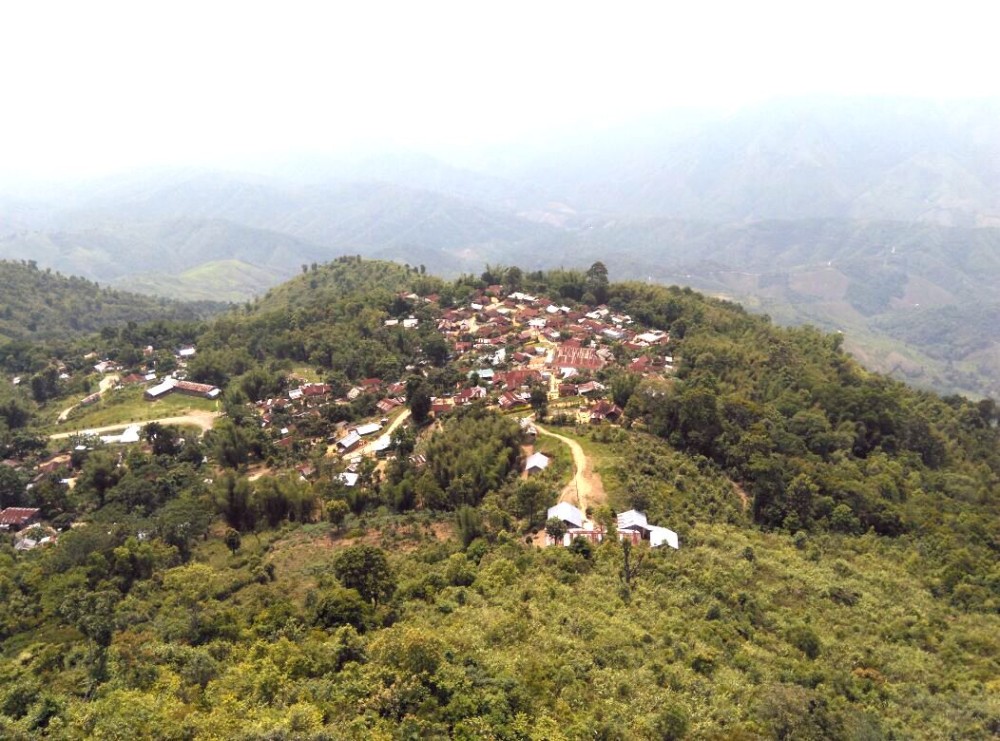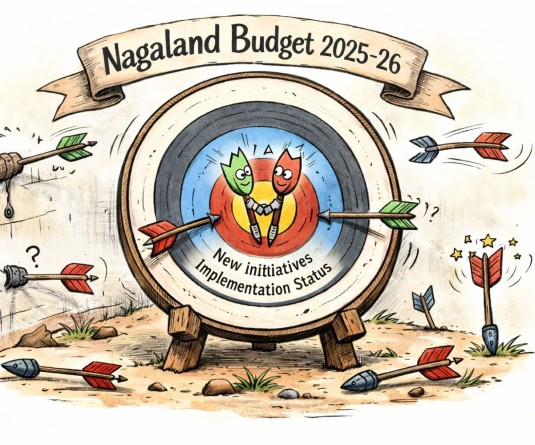An aerial view of New Riphyim village amidst a spreading green cover. (Morung Photo)

Since 2015, the efforts of Natural Nagas on a green dream project at New Riphyim village have made long strides; jhum cultivation has reduced and now UNESCO wants the area under its MAB programme
Imti Longchar
Wokha | March 17
Located 14 kilometers away from Wokha town, New Riphyim, a small village of 116 households, is leading the way in environment and wildlife conservation in Nagaland and telling the world that there is still hope in the midst of the rampant environmental degradation.
Cradled on a picturesque triple peak Mt. Morashen, New Riphyim, which has a commanding view of the Doyang valley and the reservoir, has become a perfect setting for eco tourism, integrated community farming, conservation of forest and wildlife that even the UNESCO has elicited willingness to include it in its Man and Biosphere (MAB) programme.
MAB programme is an Intergovernmental Scientific Programme that combines the natural and social sciences, economics and education to improve human livelihoods and the equitable sharing of benefits, and to safeguard natural and managed ecosystems, thus promoting innovative approaches to economic development that are socially and culturally appropriate, and environmentally sustainable.
New Riphyim pledged to go green on June 5, 2015 on World Environment Day 2015 under the initiative of the Natural Nagas, an NGO with the motto “for the community, by the community and of the community.”
True to its oath, the community, within a span of one year has ushered in transformative changes in the village that can only be “wishful thinking” for many stakeholders in the fight for environment conservation.
No to jhumming
To begin with, the primary focus of the green village project was to discourage and reduce jhum cultivation, a traditional slash and burn method of farming and protect the eco system. Jhumming is one of the main factors leading to the shrinking forest in the Nagaland landscape. It has been difficult to put a complete stop to this agriculture practice because it is closely tied to the culture and ancestry of the people.
In a show of willingness to accept to change for a better future, within one year, New Riphyim village has seen a decrease in the practice of jhum cultivation, attested by the village council chairman, Nyimtsemo Odyuo himself.
According to Nyimtsemo, jhumming has been reduced by 50% of the village population as on February 2017. “Jhum is a traditional practice and we cannot stop it in a go. It needs time,” the village council chairman, who himself had quit the jhum practice, however pointed out.
The most heartening aspect of this accomplishment is that the village council had not imposed any decree or order on the villagers to stop practice of jhum cultivation. It came as individual decisions from among the villagers, of course, with extensive awareness carried out by the Natural Nagas.
“The villagers were apprehensive at first, some openly opposing to the changes being introduced while expressing fear on the impact to their farming practices and economy which is highly stepped in culture and tradition. The men folk were the toughest to convince, but with the help of the church and the women, their mindsets gradually changed,” Steve Odyuo, founder of Natural Nagas recalled.
The village is now exploring the potentials of Integrated Farming System (IFS) to meet the demand of food supply, income generations, employment generation and sustainable development of agriculture by integration of various farming enterprise like mixed and multiple cropping system, bamboo plantation, animal husbandry, fishery, forestry etc.
On the importance of IFS, Steve said the village’s success in completely ending the practice of jhum cultivation depends on the success of the alternative source of cultivation/farming.
To this effect, the Natural Nagas have also undertaken a number of capacity building activities to address sustainable livelihood issues for the villagers- food production, processing and marketing, eco tourism, handloom and weaving, bee keeping, training on bamboo and its products to name a few.
100% economic kitchen, energy reserve and sanitation
The success of the village in living up to the green village project is not confined on ending the practice of jhum cultivation alone.
With a very receptive community- the village council, church, women hoho and student bodies looking at each other as equal partners, New Riphyim, have transformed into a model village and achieved cent percent success on a number of activities that affect change to the environment.
A walk around the village will testify to the claims. All village households utilize the economic kitchen chullah, which according to Steve, saves 70% of firewood for cooking. There is 100% CFL bulb usage in the village to save power consumption, which is an initiative of the village church.
Besides the conservation of forest and energy resources, sanitation and cleanliness is also of utmost importance, where the womenfolk play a primary role. There is a strict rule banning throwing of garbage, waste in public places and surroundings and it is mandatory to conduct social work every week by the villagers.
Further, every household in the village has a compost pit for degradable waste management and recycling of biodegradable waste product as a source of organic manure. The village is 100% open defecation free. The villagers also cultivate 100% organic vegetables and food grains.
Flame of the forest
Another significant achievement of New Riphyim is on forest and wild life conservation. On any given morning, Mt. Morashen, which is a community-reserved forest, will echo with nostalgic chirpings of different species of birds, the only forest in the surrounding area where there is high concentration of the winged visitors.
This reserved forest is also a botanical garden for identification, conservation, documentation and multiplication of economic and indigenous wild plant species. On the fringes, the villagers have also ingeniously conserved an area where choral trees like the erythrina or the flame of the forest (to attract winged visitors) and other indigenous trees and plants are planted.
New Riphyim village will also be the first village to have the Biodiversity Management Committee (BMC) in Nagaland.
“As responsible people, we the citizens of New Riphyim have pledged to take this one small step of the thousand steps ahead, to work collectively for conservation and promotion of a healthy environment,” Steve, who also hails from the village maintained. He also points out that “the success in environment conservation has so far been possible because the whole community is talking the path with a single mind.”
New Riphyim may not be the first green village in Nagaland, but it is in the forefront of stepping up to the challenge of conserving the disappearing wildlife and environment.






